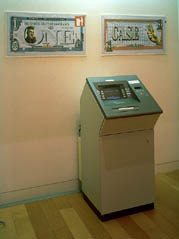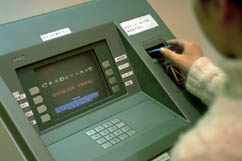

|
| Technical Details: NCR creditcard
machine, computer, dimensions: 170 x 100 x 60 cm |
|
In our everyday lives, - as if it is the most natural thing in the world - we make use of a large variety of technological appliances which have almost become indispensable prostheses. Without hesitation and full of self-confidence, we utilize apparatus which, we have been led to believe, makes our lives easier and expedites communication. Life without all these seductive machines has become unimaginable. We yearn for more, or even better, appliances designed to make our bliss complete. Of course, industry, trade and advertising ingeniously exploit this self-created need, by launching new versions every year and writing off the old models. Faster, more compact, stronger, more efficient, smaller or larger, as the case may be. What is new today, will, inevitably and almost by necessity, be old tomorrow, or the market and our euphoric belief in progress would collapse.
With great devotion we have put ourselves at the mercy of technology. We are shocked
when it sometimes appears to turn against us, even to be belligerent. Indeed,
surveillance cameras, data banks storing personal data without our knowledge,
wire-tapping apparatus, etc., are all driven by the same basic technology which
makes our common-or-garden domestic appliances work. Dumb-founded and helpless
are we if the machinery lets us down, refuses to work, and less and less are we
able to cope with repairs. We all go in for user-friendly, confidence-inspiring
interfaces, for glittering, desirable, hardware and quick results, but the hidden
mechanisms have long been beyond our comprehension.
At the same time, much of this technology renders the need for physical contact or personal exchanges with others superfluous. Our interaction with machines happens at the expense of that with other people. Financial transactions, for example, are also being conducted more and more often with the help of digital apparatus. Where we once went to the bank to withdraw money from the cashier, we now 'tap' banknotes from a cash dispenser. Quick and convenient, at least as long as the machine does not swallow up your card for some mysterious reason...
Kees Aafjes' new installation Credit Art plays on our slavish subservience to technology and lures the viewer into a remarkable transaction: visitors who are in possession of a credit card or a PIN card with a symbol corresponding to that on Aafjes' machine, can acquire, there and then (no money involved), a piece of art in the form of 'sacrificial money', designed and numbered by the artist. The only condition is that they entrust their card to the machine.
And why would they not? This is an action they have carried out countless times in everyday life, without giving a moment's thought to the fact that these are invisible transactions without evidence. However, the worst thing a card holder can imagine during the 'deed' in fact happens: once the machine has got hold of the card, the despairing user has to watch it being sawn in half on the monitor. Moreover, smoke is coming out of the machine and, disastrously, it seems as if the PIN code has been made public. In short, the user pays for the sacrificial money with fear and doubt. What has happened to his credit card will remain an enigma...
Jorinde Seijdel
|
|
